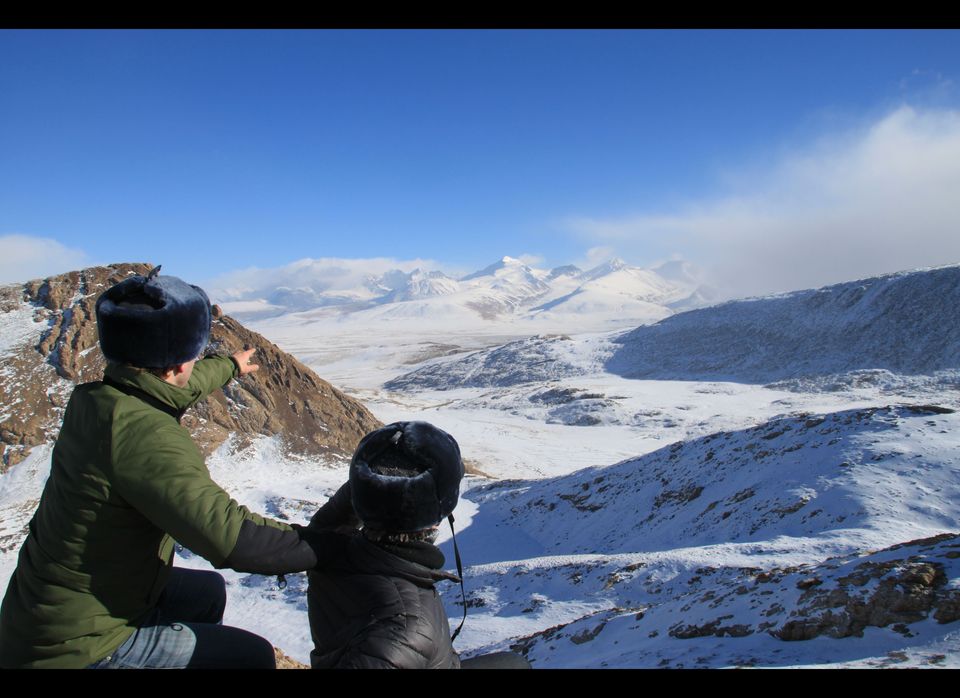A few years ago, I read The Great Game, Peter Hopkirk's account of the epic struggle for domination of Central Asia between the British and Russian empires. The explorers and soldiers profiled in the book caught my imagination and I found myself wishing I too could wander on the Silk Road. When a friend recently proposed putting together an expedition for some high-altitude hiking in the mountains of Kyrgyzstan, I agreed to join on the spot. Then, in the days that followed, doubts began to shade my enthusiasm. After all, wouldn't it be freezing? Hopkirk vividly describes harsh Central Asian winters that bedeviled even the hardiest of fur-clad explorers.
Having now made the trip, I can confirm that Kyrgyzstan is indeed very cold in winter. Despite having grown up in chilly Maine, I don't think I've ever experienced the kind of cold that is January in Kyrgyzstan. Still, visiting a country known as the Switzerland of Central Asia in the heart of a deep freeze feels rather appropriate. When the cold is simply a matter of fact, there is no point to complaining. Instead, you lace up your boots, throw on a bunch of layers, get yourself an indispensable fur ushanka hat, and head out into the wild.
We started our journey in the capital, Bishkek, a pleasant city set in the majestic Tian Shan mountains. The city is refreshingly free of chain restaurants and the usual assortment of western retailers that are ubiquitous in most world capitals. Instead, there are parks, small shops and lots of leftover real estate from Soviet times. Although Bishkek has its charms, the real action, as well as the soul of the country, lies outside the capital. Bishkek was only established as a caravan town along the Silk Road in the 1800s, while the Kyrgyz people have been roaming the steppe for over 2,000 years.
Lake Issyk Kul, a teardrop-shaped body of water located a few hours drive east of Bishkek is a natural starting point for exploration of the northern reaches of the country. Issyk Kul is the second-largest saline lake in the world, as well as the second-largest alpine lake. Its name translates to "warm lake," as it boasts a microclimate that is much warmer than the rest of the country in winter. Moreover, due in part to its salinity, the lake does not freeze.
Given this relatively balmy climate, Issyk Kul has long been an important way station on the Silk Road. The shores of the lake have been inhabited for some 2,500 years and visitors can easily access traces of this past. An open-air petroglyph museum on the lake's northern shore contains a large collection of stone drawings that date from as far back as 1500 BC. There are also several balbals, a type of stone marker that is believed to have served to mark tombs. In the United States or Western Europe, the rocks would likely be cordoned off or kept under guard, but Kyrgyzstan is slightly more laissez-faire. Sheep, dogs and horses roam among the stones and visitors can pretty much do as they please.
The Tian Shan mountains around Issyk Kul provide an inimitable setting for following the same lonely trails that were once traversed by the English and Russian operatives of The Great Game. They also provide a true sense of the arctic conditions that these brave souls faced when they traveled by foot or on horseback. While conditions might be relatively humane on the edges of the lake, the conditions in the mountains are far harsher. I've never experienced the kind of cold that I felt at 4,000 meters in Kyrgyzstan. Half of the motivation to hike up the side of a mountain in knee-deep snow is to simply try to stay warm. The reward for braving the snow drifts -- astounding views -- is worth the effort.
If The Great Game is not your thing, however, you might prefer to engage in some James Bond shenanigans instead. The Kumtor gold mine sits on a remote plateau in the eastern mountains. The mine, which contributes some 10 percent of GDP, screams "Bond film setting." It lies at the end of a long and winding mountain road that is transited mainly by supply caravans. Trucks containing cyanide line up behind police escorts, the sides of the trucks marked with warnings of their contents. In the distance, the open pit mine dominates the skyline. If I were a bond villain, I'd definitely dream up a heist at Kumtor. But I'd probably do it in summertime. Winter in the Tian Shan range is way to cold for bad guys.
